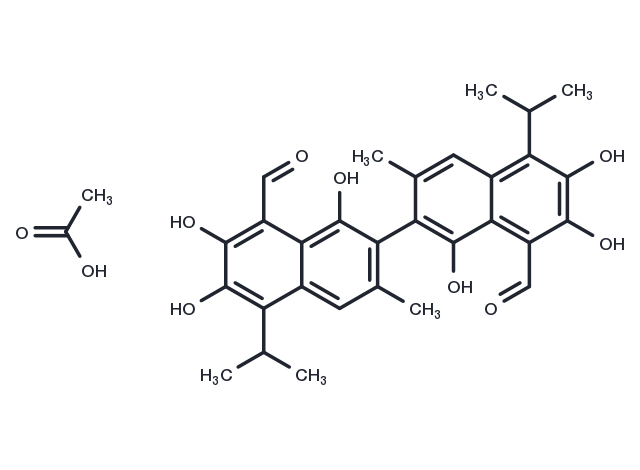Powder: -20°C for 3 years | In solvent: -80°C for 1 year


Gossypol acetic acid (AT101), a polyphenolic compound isolated from cottonseeds, binds with Bcl-2, Bcl-xL, Mcl-1, and does not inhibit BIR3 domain and BID.

| Pack Size | Availability | Price/USD | Quantity |
|---|---|---|---|
| 25 mg | In stock | $ 30.00 | |
| 50 mg | In stock | $ 39.00 | |
| 100 mg | In stock | $ 64.00 | |
| 500 mg | In stock | $ 153.00 | |
| 1 mL * 10 mM (in DMSO) | In stock | $ 43.00 |




| Description | Gossypol acetic acid (AT101), a polyphenolic compound isolated from cottonseeds, binds with Bcl-2, Bcl-xL, Mcl-1, and does not inhibit BIR3 domain and BID. |
| Targets&IC50 | BCL-XL:0.5-0.6 μM (Ki), BCL2:0.2-0.3 mM (Ki) |
| In vitro | Gossypol, a known antispermatogenic agent from the cotton plant genus Gossypium, was found to inhibit yellow perch sperm motility in vitro and lactate dehydrogenase activity in spermatozoa when used in a dose-dependent manner[1]. Gossypol has been approved to have antiproliferative and apoptosis-inducing effects on some kinds of cancer cell lines in vitro[2]. |
| In vivo | Gossypol acetate is able to inhibit tumor growth in Wus1-bearing mice, but the survival of mice is not prolonged, and tumor grows rapidly after short inhibition. Gossypol has now been found to have inhibitory effects on proliferation or to induce apoptosis in ovarian cancer, endometrial cancer, adrenal cortical tumor, thyroid cancer, lung cancer, colon carcinoma, leukemia, pancreatic cancer, melanoma and lymphoma. In addition, gossypol can increase the sensitivity of drug-resistant tumor cells to chemotherapy and radiotherapy. Some Clinicalal trials showed gossypol is well-tolerated, and partial responses are observed in some patients[4]. |
| Cell Research | MM(Multiple myeloma) cells are plated in 24-cell culture clusters at a density of 1x105 viable cells/l per well. Triplicate wells are treated with 1, 5, 10, 25 and 50 µmol/l gossypol acetate, and the negative control group is supplemented with 0.1% DMSO. Then, cell numbers at different treatment time points (0, 24, 48 and 72 h) are determined by using a hemocytometer and the trypan blue dye-exclusion method. The trypan blue dye-exclusion method is used to evaluate the cell viability. The cells are examined in a counting chamber under a light microscope. Only viable cells are recorded. (Only for Reference) |
| Source |
| Synonyms | (±)-Gossypol-acetic acid, Pogosin, AT101, Gossypol acetic acid |
| Molecular Weight | 578.61 |
| CAS No. | 12542-36-8 |
Powder: -20°C for 3 years | In solvent: -80°C for 1 year
H2O: < 1 mg/mL (insoluble or slightly soluble)
DMSO: 100 mg/mL (172.82 mM)
Ethanol: 2 mg/mL(3.5 mM)
You can also refer to dose conversion for different animals. More
bottom
Please see Inhibitor Handling Instructions for more frequently ask questions. Topics include: how to prepare stock solutions, how to store products, and cautions on cell-based assays & animal experiments, etc.
Gossypol (acetic acid) 12542-36-8 Apoptosis BCL (±)-Gossypol-acetic acid acetic acid inhibit Gossypol-acetic acid Pogosin AT 101 Inhibitor AT-101 AT101 Gossypol BL-193 (acetic acid) Bcl-2 Family Gossypol acetic acid inhibitor
